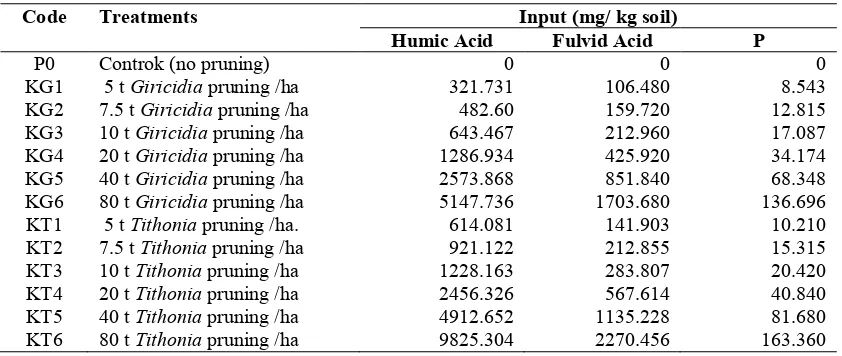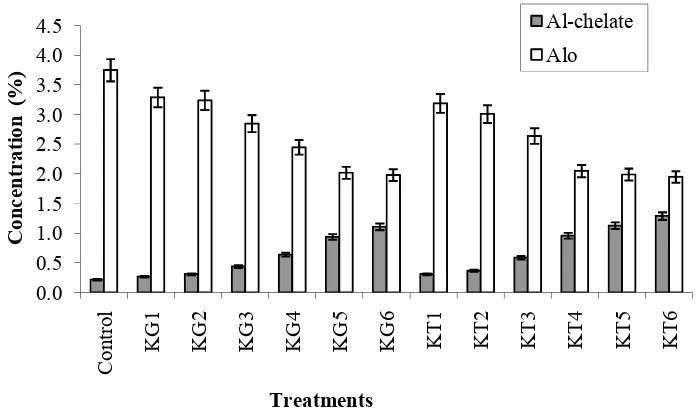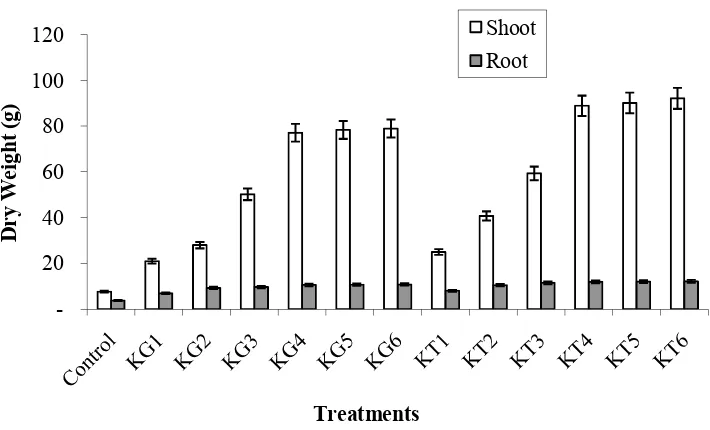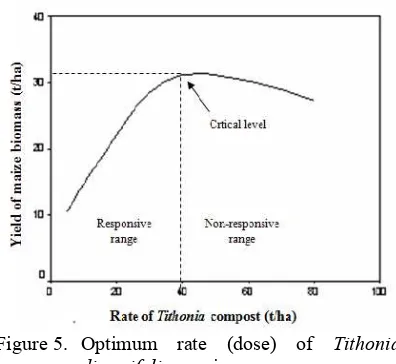ISSN: 2339-076X, Volume 2, Number 2 (January 2015): 259 - 266
DOI:10.15243/jdmlm.2014.022.259
Research Article
The potential of legume tree prunings as organic matters for
improving phosphorus availability in an acid soil
I. Wahyudi
1*, E. Handayanto
21Faculty of Agriculture, Tadulako University, Central Sulawesi, Indonesia 2
IRC-MEDMIND, Brawijaya University, Jl. Veteran, Malang 65145, Indonesia
*corresponding author: [email protected]
Abstract:
A study that was aimed to elucidate roles of Gliricidia sepium and Tithonia diversifoliaprunings and their extracted humic and fulvic acids on improving phosphorus availability and decreasing aluminum concentration in an Ultisol was conducted in a glasshouse. Thirteen treatments consisting of two prunings, six rates of pruning application (5, 7.5, 10, 20, 40 and 80 t/ha) and one control (no added prunings) were arranged in a randomized block design with four replicates. Each mixture of prunings and soil was placed in a pot containing 8 kg of soil and maize of Srikandi cultivar was grown on it for 45 days. At harvest, soil pH, P content and aluminium concentration were measured. Results of the glasshouse experiment showed that application ofGliricidiaandTithoniaprunings significantly increased soil pH, reduced Aloconcentration, increased Alpcontent, increased P availability, and increased P taken
up by maize grown for 45 days. The optimum rate of bothGliricidiaandTithoniapruning should be 40 t/ha. However, at the same rate, optimum production gained byTithonia would be higher than that of
Gliricidia.
Keywords: acid soil, legume trees, phosphorus, prunings.
Introduction
A major part of the tropics is characterized by acid soils of low inherent fertility known as Oxisols and Ultisols (Swift and Sanchez, 1984). In Indonesia, these soils are widespread throughout Kalimantan (21,938,000 ha), Sumatera (9,469,000 ha), Maluku and Papua (8,859,000 ha), Sulawesi (4,303,000 ha) and Java (1,172,000 ha) (Prasetyo and Suriadikarta, 2006). Such soils are generally characterized by low cation exchange capacity, low base saturation, high soluble aluminium, low pH and low organic matter content (Sri Adiningsih et al., 1988).
Improvement of Ultisol productivity can obviously be made through application of inorganic fertilizer and /or liming. However, fertilizer application is usually ineffective as such soils pose low buffering capacity due to low organic matter content. In addition, the high solubility of aluminium leads causes a greater part of applied phosphorus (around 70%) becomes unavailable for plant use due to adsorption by soluble aluminium (Bates and Lynch, 2001).
Another practice commonly employed to solve acidity and aluminium toxicity problems in Ultisols is liming (Wawan, 2000). However, over liming can reduce availability of P and Mn (Radjagukguk, 1983).
large amounts are usually beyond the reach of upland farmers. The relationship between organic matter application and nutrient release, especially nitrogen, has been enormously studied, but studies on the effects of organic matter application on improving phosphorus availability in Ultisols are relative few.
Besides the release nutrients, other short term beneficial effects of organic matter application have not been drawn to the attention of the users. Currently, very little information is available of these practical influences. In Ultisols, an increase in soil pH and the reduction of soil aluminium concentrations are very important at establishment to guarantee good germination and emergence after showing.
Organic acids present in the organic matters or produced during their decomposition have been shown to interact strongly with phosphorus adsorption as they compete for the same sites (Appelt et al., 1975; Hue et al., 1986). This increases phosphorus availability, which a consequent of soil property change also contributes to the improvement in crop production. Therefore, when organic matter management is considered in the context of shortage, both short-term and long-term benefits of organic matter amendment on beneficial changes other than nutrient release need to be taken into account.
Considering to the variable amount and quality of organic matters, selection of organic maters needs to consider their availability in the field, their potential use for organic fertilizers as well its common use by farmers. Amongst various sources of organic matter, prunings ofGliricidia sepium and Tithonia diversifolia are commonly used for improving soil productivity. Gliricidia sepiumis a legume tree that can easily be found as living hedges and shelters in rural areas throughout Indonesia. This tree is also commonly used by villagers as fuel wood and animal feed.
Tithonia diversifoliais a shrub type of vegetation that can also easily be found in rural areas. Prunings of those two organic matter sources are very potential for supplying nitrogen and phosphorus. They also contain substantial amounts of humic and fulvic acids that can reduce soil aluminium toxicity. Supriyadi (2003) reported that application of Tithonia diversifolia prunings in an Andisol increased Al-chelate from 1.30% to 1.49% during 30 days of incubation.Minardi et al. (2007a) reported that application of Gliricidia sepium prunings in an Andisol reduced Alo by
29.85% which in turn released phosphate into soil solution.
In this study, a glasshouse experiment was conducted to judge the role of organic matter
addition in decreasing aluminium toxicity and phosphorus availability of an Ultisol and their impact on crop growth.
Materials and Methods
Fresh Prunings ofGliricidia sepiumandTithonia diversifolia collected from Jatikerto Village of Malang, were oven dry at 60oC for 48 hours for organic-C, total N, and total P, humic acid and fulvic acid contents. Humic and fulvic acids from the prunings were extracted using 0.01 N NaOH. Chemical composition of Gliricidia sepium and
Tithonia diversifolia prunings is presented in Table 1.
Each of the fresh prunings was chopped at 1-2 cm and applied soil in a 10 kg plastic pot. The soil used for this study was top soil of an Ultisol collected from Kentrong Village of Cipanas District, Lebak Regency, Banten Province. The soil has the following characteristics: pH 4.3, 38.1 mg total P/kg soil, 5.79 mg available P/kg soil, 68.18% Al saturation, 11.85 meq exchangeable Al/100g soil, 1,10 meq exchangeable H/100g soil, 1.99% organic-C, 0.20% total N, and C/N ratio of 9.99. Thirteen treatments (Table 3) were arranged in a randomized block design with three replicates. For each treatment, 8 kg of air dried top soil (0-30 cm depth) that passed through 2 mm sieve was mixed with pruning and placed in a 10 kg plastic pot. All pots received basal fertilizers consisting of 250 kg Urea/ha and 50 kg KCl/ha. Three pre-germinated seeds of maize, cultivar Yellow Srikandi were planted in each pot and thinned to one best plant after 1 week. The unused plants were returned and incorporated into the soil.
The experiment was conducted for 45 days. Water was supplied daily to each pot in order to keep the moisture content of the soil at the approximate field capacity. At harvest (45 days after planting), maize shoots were harvested from all pots at a height of 1 cm above the soil surface. Roots were separated manually from the soil by sieving and rinsing with water. The shoots and roots were then oven dried at 60oC for 48 hours, weighed and ground to pass through a 1 mm sieve. P content of shoots and roots was analyzed using HClO4+ HNO3extraction method. P uptake
was calculated by multiplying P concentration and plant dry weight.
Soil indicators determined included: soil pH (pH H2O and pH KCl) using a glass electrode
method (pH mete), inorganic P was extracted using H2SO4 0.5 M, total P was measured as
and organic P; available P was determined using Bray II method; exchangeable Al was extracted using 1N KCl, Al chelate, Al-oxs, and P adsorption were determined using Blackmore method. Statistical analysis was performed at
significant levels of 5% and 1%. Differences between treatments were tested using Duncan multiple range test. Correlation and regression analyze were performed to judge relationships between measured parameters.
Table 1. Treatments of Glasshouse experiment.
Code Treatments Input (mg/ kg soil)
Humic Acid Fulvid Acid P
P0 Controk (no pruning) 0 0 0
KG1 5 tGiricidiapruning /ha 321.731 106.480 8.543
KG2 7.5 tGiricidiapruning /ha 482.60 159.720 12.815
KG3 10 tGiricidiapruning /ha 643.467 212.960 17.087 KG4 20 tGiricidiapruning /ha 1286.934 425.920 34.174 KG5 40 tGiricidiapruning /ha 2573.868 851.840 68.348 KG6 80 tGiricidiapruning /ha 5147.736 1703.680 136.696 KT1 5 tTithoniapruning /ha. 614.081 141.903 10.210
KT2 7.5 tTithoniapruning /ha 921.122 212.855 15.315
KT3 10 tTithoniapruning /ha 1228.163 283.807 20.420 KT4 20 tTithoniapruning /ha 2456.326 567.614 40.840 KT5 40 tTithoniapruning /ha 4912.652 1135.228 81.680 KT6 80 tTithoniapruning /ha 9825.304 2270.456 163.360
Results and Discussion
Soil Al and pH
Application of Gliricidia and Tithonia prunings significantly reduced Alexch concentration from
11.73 meq/100g to 2.29 meq/100g (Table 2). The lowest concentration of Alexch was observed for
application ofTithoniapruning at a rate of 80 t/ha (KT6) from 11.73 meq/100g to 2.29 meq/100g or reduced by 80.48%. The sharp decrease of Alexch
concentration due to application of Gliricidia
pruning occurred at rate of 40 t/ha and for
Tithonia at a rate of 20 t/ha. No sharp increase was observed at a higher application rate. It was likely that application ofTithoniapruning resulted in lower concentration of Alexch than that of
Gliricidiapruning.
The low reduction of Alexch concentration at
application rate of more than 20 t/ha forTithonia
pruning and 40 t/ha for Gliricidia pruning might be related to transformation mineralized NH4
+
to NO3-. This anion will bind Al3+ to form unstable
complexes (Lindsay, 1979).
In agreement with Alexch concentration
reduction, application of Gliricidia and Tithonia
prunings significantly reduced Alo concentration
and increased Alp (Alchelate) (Figure 1). Alo
concentration was reduced from 3.75% to 1,98% forGliricidiatreatment, and from 3.75% to 1.95% for Tithonia pruning treatment. The highest percentage of the Alo reduction (22.35%) was
observed for application of 20 tTithoniapruning /ha, followed by application ofGliricidiapruning
40 t /ha (17.55%) (Figure 1). At higher rates of pruning application, the reduction of Alotended to
decrease, i.e. 2.93% for Tithonia at a rate of 40 t/ha and 2.01% for 80 t/ha, and 1.98% for
Gliricidiaat a rate of 80 t/ha.
Table 2. Changes of Alexch and soil pH due to
application of Gliricidia and Tithonia
prunings.
Control 11.73 m 4.40 a
KG1 9.09 l 4.84 b
Alpconcentration increased from 0.22% to 1.11%
for Gliricidia pruning treatment and from 0.22% to 1.29% for Tithonia pruning treatment (Figure 1). Application of 20 t Tithonia pruning /ha resulted in 62.71% of Alchelate increase. Such an
about 60 tGliricidiapruning /ha as application of 40 kg/kg only increased Alchelate by 46.88%.
Patterns of Alp increase and Alo decrease were
very similar to Alexchreduction pattern. This is in
agreement with results of experiment 1 which indicated that Tithoniapruning was stronger than
Gliricidia pruning reducing Alexch and increasing
Alchelate. Supriyadi (2003) has reported that
application ofTithonia diversifoliaprunings on an Andisol of Tawangmangu significantly increased formation of Alchelate in the soil. Furthermore,
application ofGliricidiaprunings on the same soil type reduced Aloconcentration by 29.85% which
led to the release of phosphate into soil solution (Minardi et al., 2007b).
Application of Gliricidia and Tithonia
prunings significantly increased soil pH. The highest pH was due to application of 80 tTithonia
compos / ha (KT6).The pH has increased from 4.4 to 5.99 after 45 days (Table 2). As expected, pH increases due to application of Tithonia pruning were greater than those ofGliricidiapruning. This might be related to the higher contents humic and fulvic acids of Tithonia pruning than Gliricidia
compos (Table 1).
Figure 1. Effects of application ofGliricidiaandTithoniaprunings on concentration of soil Alchelateand
Alo(KG:Gliricidiapruning; KT:Tithoniapruning: 1, 2, 3, 4, 5 and 6 are rates of 5, 7.5, 10, 20,
40 and 80 t/ha, respectively).
Based on the percentage of pH increase, application of 80 t Tithonia/ ha resulted in the higher percentage of pH increase (36.14%), compared to that of Gliricidia application at similar rate (33.64%). As discussed above, this indicated the stronger roles of humic and fulvic acids derived fromTithonia pruning than that of
Gliricidia pruning in contributing additional free OH ion to soil solution (Mokolobate and Haynes (2002). The pH increase could also be due to the present of base cations that were released during decomposition of the prunings leading to the increase of OH ion concentration in soil solution (Hairiah et al., 2000).
Soil phosphorus
Application of 80 t Tithonia and Gliricidia
prunings reduced P adsorption in the soil by 74.77% and 68.71%, respectively (Table 3). This resulted in significant increases of available P in the soil. In general, the percentage of soil
available P increase due to application ofTithonia
pruning was greater than that applied with
Gliricidia pruning. This is, again, in agreement with pattern of soluble aluminium reduction in the soil (Table 2).
Reduction of Alexch content due to chelate
formation made by humic and humic acids has weakened Al reactivity to P which led to the decrease of P adsorption and accordingly available P increase. According to Weil and Magdoff (2004), organic acids (including humic and fulvic acids) that produced during decomposition of organic matter can reduce activity of aluminium through formation of organic-metal complexes which leads to pH increase, release of adsorbed P and increase of available P for plant uptake. Calculation of P balance showed that the amount of total P (soil available P, P taken up by maize, and release of P adsorbed) at harvest (45 days) was higher than that at planting time.
Table 3. Changes in Soil P status as affected by application of Tithonia and Gliricidia
prunings.
Treatment *)
P adsorption (%)
Available P (mg/kg)
Control 85.47 m 7.26 a
KG1 81.16l l 7.69 b
KG2 76.69j j 9.84 c
KG3 70.01 i 12.28 f
KG4 58.02 f 16.00 h
KG5 37.70 d 20.88 j
KG6 26.74 b 24.59 i
KT1 79.19 k 9.99 d
KT2 69.89 h 12.20 e
KT3 60.21 g 14.55 g
KT4 48.58 e 19.43 i
KT5 31.02 c 24.44 k
KT6 21.56 a 31.07 m
*) see Table 2
The higher additional available P than additional total P was caused by addition of P released from adsorption. The increase of available P due to application of the prunings has led to the increase of P recovery in maize, particularly at application of 10 t pruning/ha. The remaining available P in the soil (not taken up by plant) is thought to be in
the form of P microbial biomass, or rebound by aluminium.
Growth of maize
Application of either Gliricidia pruning or
Tithonia pruning significantly affected plant height, shoot dry weight and root dry weight (Figures 2 and 3). Shoot and root dry weights increased with increasing rate of pruning applied to the soil. The highest shoot and root dry weight was observed when the soil was applied with of 80 t pruning/ha (Figure 3). Application of 80t
Gliricidiapruning/ha produced 78,95 g dry shoot and 10,81 g dry root, that of 80t Tithonia
pruning/ha produced 92,17 g dry shoot and 12,19 g dry root (Figure 3).
Increasing shoot and root dry weight due to application of prunings led to increasing shoot: root ratio by 1.5-3.5 times compared to control treatment. This indicated that there was no growth inhibition for the maize. It is widely known that shoot: root ratio can be used an indicator of shoot-root functional relationships. A low shoot: shoot-root ratio indicates the present of root growth inhibitors that affecting shoots development.
Figure 2. Effects of application ofGliricidiaandTithoniaprunings on maize shoot and root dry weights (KG:Gliricidiapruning; KT:Tithoniapruning: 1, 2, 3, 4, 5 and 6 are rates of 5, 7.5, 10, 20, 40 and 80 t/ha, respectively).
-20
40
60
80
100
120
D
ry
We
igh
t
(g)
Treatments
Shoot
Figure 3. Effects of application ofGliricidiaandTithoniaprunings on maize plant height (KG:Gliricidia
pruning; KT: Tithoniapruning: 1, 2, 3, 4, 5 and 6 are rates of 5, 7.5, 10, 20, 40 and 80 t/ha, respectively).
Using a quadratic model of Y = bo+ b1X+b2X2,
where Y = yield of maize biomass (shoot + root), X = rate pruning application, b1 and b2 are
regression coefficients, and bo is a constant, to
estimate rate of pruning application to yield a maximum maize, it was known that equation for the model is Y = 3.28 + 0.93X – 0.009X2 for
Gliricidia pruning, and Y = 5.81 + 0.99X – 0.009X2 for Tithonia pruning (Figures 4 and 5). Based on the equations it can be estimated that an optimum rate ofGliricidiapruning was similar to that of Tithonia pruning, i.e. approximately 40t/ha.
Figure 4. Optimum rate (dose) of Gliricidia sepiumpruning
Application of 40 tGliricidiapruning /ha yielded maize biomass of 25.86 t/ha, but application of 40
Tithonia pruning / ha yielded maize biomass of 31.13 t /ha. Application of either Gliricidia or
Tithoniapruning at rates higher than 40t /ha will
decrease biomass yield, for examples; application of 80 t Gliricidia pruning /ha will yield 19.77 t biomass / ha (24% decrease), and application of 80 t Tithonia pruning /ha will yield 27.65 t biomass/ha (11% decrease). The higher maximum yield obtained byTithoniapruning thanGliricidia
pruning was thought to be related to the difference contents of humic and fulvic acids of the prunings (Table 1) that resulted in differences in reduction of Alexchand increase of available P.
Figure 5. Optimum rate (dose) of Tithonia diversifoliapruning
P-uptake by maize
Application of Gliricidia and Tithonia prunings enhanced P uptake by maize with a maximum uptake of 45 mg P/kg soil for KT6 treatment (80 t
Tithonia pruning/ha). In general, P uptake increased with increasing rate of pruning applied
-20 40 60 80 100 120
P
la
n
t
H
ei
g
h
t
(c
m
)
(Figure 6). A better growth of maize grown on soil amended with Tithoniapruning compared to that of Gliricidia was in accordance with strong roles ofTithonia pruning in reducing aluminium solubility, increasing soil pH and improving P availability of the soil. Results of this study is in
line with previous studies on the roles ofTithonia
prunings in increasing P uptake in soils having high P adsorption (Jufri, 1999; Supriyadi, 2003), and roles of Gliricidia prunings in improving P availability in an Andisol (Minardi et al., 2007b).
Figure 6. Effect of application ofGliricidiaandTithoniaprunings on P-uptake by maize at 45 days (KG:
Gliricidiapruning; KT:Tithoniapruning: 1, 2, 3, 4, 5 and 6 are rates of 5, 7.5, 10, 20, 40 and 80 t/ha, respectively).
Data presented in Table 4 show that the increase of shoot dry weight and P uptake by maize were strongly correlated with changes of soil chemical properties (P availability, pH (H2O), Alexch and
Alp).
Table 4. Coefficient of correlations (r) between changes in soil chemical properties, maize shoot dry weight and P uptake by maize.
Available P 0.91 0.94
pH (H2O) 0.95 0.96
Alexch - 0.97 - 0.98
Alp 0.93 0.96
Improvement of P availability has led to improvement of P uptake by maize. As discussed above, this is related to the decrease of Alexchdue
to humic and fulvic acids present in the prunings of produced during their decomposition process. In addition, the increase of available P could also
be mineralization of organic P formerly present in the prunings. This strongly indicated the beneficial effects of amendment on improving phosphorus availability and decreasing aluminium toxicity in an Ultisol, which in turn improving plant growth.
Conclusion
Application of Gliricidia and Tithonia prunings significantly increased soil pH, reduced Alo
concentration, increased Alp content, increased P
availability in an acid soil, and increased P taken up by maize grown for 45 days.
Acknowledgements
The first author wishes to thank the Directorate General of Higher Education, and Tadulako University, Indonesia for financial support to undertake this study.
References
Appelt, H., Coleman, N.T. and Pratt, P.F. 1975. Interaction between organic compounds, mineral and ions in volcanic ash derived soils. II. Effects of organic compounds on the adsorption of phosphate.
Soil Science Society of America Proceeding 39: 623-630.
Bates, T.R. and Lynch, J.P. 2001. Root hairs confer a competitive advantage under low phosphorus availability.Plant and Soil236: 243-250.
Hairiah, K., Widianto., Utami, S.R., Suprayogo, D., Sunaryo., Sitompul, S.M., Lusiana, B., Mulia, R., van Noordwijk, M. dan Cadish, G. 2000. Pengelolaan Tanah Masam Secara Biologi: Refleksi Pengalaman dari Lampung Utara. ICRAF.
Hue, N.V., Craddock, G.R. and Adams, F. 1986. Effect of organic acids on aluminium toxicity in subsoil.
Soil Science Society of America Journal50: 28-34 Jufri, J. 1999. Peningkatan Ketersediaan P Oleh
Beberapa Macam Bahan Organik Pada Ultisol. Tesis S2 PPS Universitas Brawijaya, Indonesia. Lindsay, W. L. 1979. Chemical Equilibrium in Soils.
John Wiley & Sons. New York.
Minardi, S., Suntoro, Syekhfani. dan Handayanto, E. 2007a. Peran asam humat dan fulvat dari bahan organik dalam pelepasan P terjerap pada Andisol.
Agrivita29: 15-22
Minardi, S., Suntoro, Syekhfani. dan Handayanto, E. 2007b. Penggunaan macam bahan organik dengan kandungan total asam humat dan fulvat berbeda dan pupuk P terhadap ketersediaan dan serapan P pada tanaman jagung manis.Agrivita29:131 – 137 Mokolobate, M.S. and Haynes, R.J. 2002. Increases in
pH and soluble salts influence the effect that additions of organic residues have on concentrations of exchangeable and soil solution aluminium. European Journal of Soil Science 53: 481-489.
Notohadiprawiro, T. 2006. Budidaya Organik: Suatu Sistem Pengusahaan Lahan Bagi Keberhasilan Program Transmigrasi Pola Pertanian Lahan Kering. Repro: Ilmu Tanah UGM-Yogjakarta. h: 1-10.
Prasetyo, B.H. dan Suriadikarta, D.A. 2006. Karakteristik, potensi, danteknologi pengelolaan tanah ultisol untuk pengembangan pertanian lahan kering di Indonesia. Jurnal Litbang Pertanian 25 (4): 39-46.
Radjagukguk, B. 1983. Masalah Pengapuran Tanah Mineral Masam di Indonesia.
Sri Adiningsih, J., Sudjadi, M. and Setyorini, D. 1988. Overcoming soil fertility constraints in acid upland soils for food crop based farming systems in Indonesia. Indonesian Agricultural Research and Development Journal10: 49-58.
Stevenson, F.J. 1994. Humus Chemistry: Genesis, Composition and Reaction.
Supriyadi. 2003. Studi Penggunaan Biomasa Tithonia diversifolia dan Tephrosia candida Untuk Perbaikan P dan Hasil Jagung (Zea mays L) di Andisol. Disertasi PPS Universitas Brawijaya, Indonesia. 172 h.
Swift, M. J. and Sanchez, P.A. 1984. Biological management of tropical soil fertility for sustained productivity.Nature and Resources20: 2-10. Tan, K.H. 1998. Principles of Soil Chemistry. Marcel
Dekker Inc., Madison, New York.
Wawan. 2002. Pengelolaan Subsoil Masam Untuk Peningkatan Produksi Tanaman Pangan. Makalah Falsafah Sains. PPS-IPB, Bogor.
Weil, R.R. and Magdof, F. 2004. Significance of soil organic matter to soil quality and health. In: Magdof, F. and Weil, R.R. (eds), Soil Organic Matter in Sustainable Agriculture. pp 1-36. Yusuf, W.A., Jumberi, A., Haris, A. dan Simatupang,
R.S. 2004. Pengaruh pemberian pupuk organik terhadap fitotoksitas aluminium pada tanah masam.




